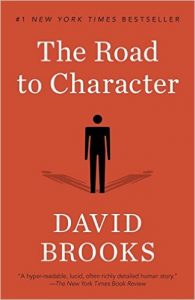
David Brooks’ latest masterpiece, THE ROAD TO CHARACTER, is an important (really meaning “essential”) new read for all leaders who seek to meaningfully mentor teenagers and young adults. The highly engaging 275 pages will hold your attention and produce many an “aha! moment” as the reader is led to think through the transition of attitudes in our world moving from the 20th to the 21st Centuries. This is not light reading, but neither is it so heavy that the reader is left behind or made to flounder for long. I began reading the book at 10pm one evening and had difficulty putting it down to go to bed. I am neither a speed reader nor a super-retainer of what is read, but I found these pages packed with great truth, insight, and wisdom. I was riveted by how amazingly on-target this writing is.
Upon taking in the first few pages, readers may discover a quickening commitment to finish this book. One who reads the “Introduction: Adam II” will soon sense that this is critically important material which needs to be thought through thoroughly. The author even gives the patience-challenged reader the “permission” to skip over to the end of the book to read the summary if needed. However, you may never be tempted to do that, because it becomes obvious that the thought process is just as crucial as the conclusions, likely even more so.
There will be series of sentences or even a few paragraphs where you might wonder where the author is headed or the direction the reader is being led. I encourage you to stay with the reading, because a significant surprise or two will not only regain your interest but will also renew your confidence that this writer is really onto something tremendously important.
One of the most fascinating features of the book is the author’s treatment of the term “sin.” At just the point he seems to be signing off on a traditional liberal, then conservative theology, he exposes new definitions that are so practical and logical that it catches the reader off guard and disarms the rush to our traditional conclusions. In music, this would be called a deceptive cadence, surprising the listener by the final harmonic progression of a phrase. The result in this book is that our faith becomes refreshed and consequently strengthened as we view that one term from other angles than just the old, stodgy, threadbare concepts which often fail to communicate in our 21st Century society. You may even disagree with the author’s ultimate analysis of sin or other terms, but either way, the reader will be stronger and more compassionate for having considered them.
There are other age-laden terms the author dares to address with updated conviction and commitment.
I cannot image anyone not being challenged, informed, inspired, and blest by the thoughtful digesting of this book. Your reading of it and sharing it with friends – both in book form and in discussion – is highly recommended and encouraged.
Randy Edwards









